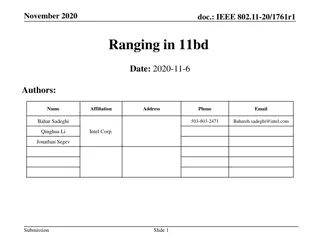
Understanding Subspaces Associated with a Matrix by Hung-yi Lee
Explore the concept of subspaces associated with a matrix as explained by Hung-yi Lee, including details on column space, null space, row space, and their dimensions. Learn how to find bases and dimensions for these subspaces through examples and explanations from Chapter 4.3 of the reference textbook. Gain insights into the properties and interplay of these subspaces in the context of linear algebra.
Download Presentation

Please find below an Image/Link to download the presentation.
The content on the website is provided AS IS for your information and personal use only. It may not be sold, licensed, or shared on other websites without obtaining consent from the author. If you encounter any issues during the download, it is possible that the publisher has removed the file from their server.
You are allowed to download the files provided on this website for personal or commercial use, subject to the condition that they are used lawfully. All files are the property of their respective owners.
The content on the website is provided AS IS for your information and personal use only. It may not be sold, licensed, or shared on other websites without obtaining consent from the author.
E N D
Presentation Transcript
Subspaces associated with a Matrix Hung-yi Lee
Reference Textbook: Chapter 4.3
Three Associated Subspaces A is an m x n matrix Col A Null A Row A in Rm in Rn in Rn Zero vector Zero vector A A = Col AT range Basis? Dimension?
Col A Basis: The pivot columns of A form a basis for Col A. Col A = Span pivot columns pivot columns Dimension: Dim (Col A) = number of pivot columns = rank A
Rank A (revisit) Maximum number of Independent Columns Number of Pivot Columns Number of Non-zero rows Number of Basic Variables Dim (Col A): dimension of column space Dimension of the range of A
Example 2, P256 2 1 5 3 1 0 0 0 0 1 0 0 1 0 0 1 0 1 4 3 1 1 0 1 0 5 1 Null A 5 0 0 ? = ? = 2 0 5 2 2 1 5 2 3 10 Basis: Solving Ax = 0 Each free variable in the parametric representation of the general solution is multiplied by a vector. The vectors form the basis. ?1 ?2 ?3 ?4 ?5 ?1= ?3 ?5 ?2= 5?3 4?5 ?3= ?3 1 5 1 0 0 1 4 0 2 1 ?1+ ?3+ ?5= 0 ?2 5?3+ 4?5= 0 ?4 2?5= 0 = ?3 + ?5 (free) ?4= 2?5 ?5= ?5 (free) Basis
Null A Basis: Solving Ax = 0 Each free variable in the parametric representation of the general solution is multiplied by a vector. The vectors form the basis. Dimension: Dim (Null A) = number of free variables = Nullity A = n - Rank A
Row A Basis: Nonzero rows of RREF(A) RREF R= Row A = Row R (The elementary row operations do not change the row space.) a basis of Row R = a basis of Row A Dimension: Dim (Row A) = Number of Nonzero rows = Rank A
Rank A (revisit) Maximum number of Independent Columns Number of Pivot Column Number of Non-zero rows Number of Basic Variables Dim (Col A): dimension of column space = Dim (Row A) = Dim (Col AT) Dimension of the range of A
Rank A = Rank AT Proof Rank A = Dim (Col A) Rank A = Dim (Row A) = Dim (Col AT) = Rank AT
Dimension Theorem Dim (Col A) If A is mxn Dim (Null A) =n - Rank A Dim (Rn) =n =Rank A Dim of Null Dim of Range + = Dim of Domain A A range
Summary A is an m x n matrix Dimension Basis Rank A The pivot columns of A Col A The vectors in the parametric representation of the solution of Ax=0 Nullity A = n - Rank A Null A The nonzero rows of the RREF of A Row A Rank A






















